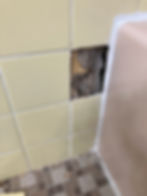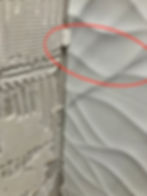Do You Have a Water Leak in Your Tiled Shower?
- david25500
- Jan 21, 2024
- 4 min read
Updated: Jan 8
Before you go spending hard-earned money on hiring a professional to diagnosis or fix what may or may not be a problem, delving out thousands of additional dollars(think, drywall, paint, mold remediation) because of an issue that could have easily been spotted (perhaps, BEFORE it leaked through your ceiling), take a look at some warnings signs we have compiled to see if your tiled shower (or floor) is leaking or beginning to deteriorate.
A problem that I am seeing more and more often these days, is a leak. There have been quite a few times that I have calls from potential customers about grout issues. Grout may be wearing away, cracking, or be discolored. This could be but a sign that you have a problem with the waterproofing, or lack thereof in your shower. Grout, often is the "canary in the coalmine," that's letting you now, you have an issue before water comes leaking though your ceiling. These are often signs that water is wicking (defined as, absorbing or drawing up water on the walls /floor) to areas that aren't waterproofed, and the water is being retained. After water is retained in such areas, the leaks occur. It can happen over the course of years, month, or days.
Unfortunately, every shower I've pulled out to replace (that has been installed by certain prominent home builders), is without any kind of waterproofing. Typically, they throw on the cement board, then just install the tile directly over ( they save time and money this way). There's never any kind of preparation such as seam taping, or application of any membrane that would offer protection against leaks; let alone, any of the more high-end shower systems such as the Schluter or Wedi systems that would offer superior protection. Improper installation will regrettably, lead to failure in the tile and additional expenses to the home owner. In an effort to prevent further damage, read on for insight on the warning signs, your tiled area is defective.
*Disclaimer- The following pictures were taken by Faithful Tile, before we remediated our customer's issues. These problems resulted from another contractor/builder not following the proper steps to waterproof, and are not examples of Faithful Tile's work.
Cracking of grout:
Water is wicking up the wall and is being retained behind the tile. Over time, the grout degrades because of the constant moisture. Or, the substrate behind it has become saturated and unstable. When that happens, the tiles become unstable ever so slightly and it ships away at the grout. Degradation of grout can also occur on shower floors that do not have a proper slope towards the drain. Industry standard is that a slope must be 1/4" per foot. If its less than that then, pooling may occur and you may have grout and tile loosening. This can also eventually lead to leaks if the water isn't draining properly.
~An example of what was lurking beneath
tile that had loose and cracked grout.
~The water leak, settled underneath the shower pan. The shower had to be pulled out so the subfloor could be repaired.
This customer called me when the ceiling on the first floor started leaking water from above.
2. Discoloration of grout/Mold:
When water/moisture is sitting behind the tile, it can cause mold and mildew. When you have to keep cleaning the tile regularly, and this discoloration keeps returning, you can deduce, you will continue to have an ongoing issue until properly addressed.
~The discoloration was evident.

~The installer (homebuilder) had not even bothered to make sure the substrate underneath overlapped the shower pan. This was always going to leak.
3. Loosening of tile:
If water is able to wick behind the tile and saturate the substrate, it's only a matter of time until the thinset (which is holding the tile to the wall/floor), will lose it's strength. Once that happens the tiles will loosen and move. If it's bad enough, you could remove the tile from the wall with your bare hands. The loosening of tiles is also an ominous sign that you unfortunately have a leak.

~This customer had a leak that spread to the adjacent room. Regrettably, I pulled this tile off without any tools but instead just by hand.

~This customer had a row of tile affected because there was faulty waterproofing behind the tiles. It's another example of a bad install, because the installer did not want to shim behind the veneer, (which was one large sheet), and as a result the veneer sat on top of the tab. From lack of waterproofing. one can see the discoloring, even after weekly cleaning by the homeowner.
4. Cracked Tile:
If you have cracked tile, that could also be a sign of a leak. Simply put, if the substrate hasn't been installed properly, it can cause tile to crack. The substrate (often is cement board) has a tendency to expand and reduce size ever so slightly. For instance, if the seams aren't taped to make one unified surface, I've seen tile crack or loosen right across these exposed seams. I would question if the substrate was also waterproofed correctly if it wasn't installed correctly also.

~An excellent example of not only a tile cracking(due to cement board behind it not taped) but also lack of waterproofing.



